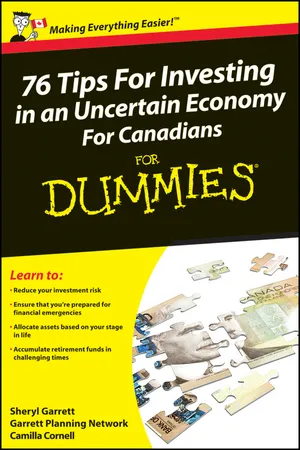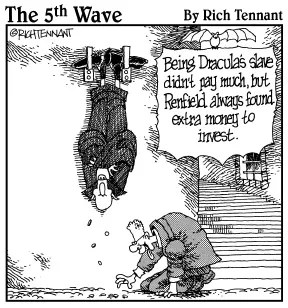Part I
Laying a Solid Foundation
In this part . . .
Before you make any investment decision, you can benefit from balancing current events with some historical perspective. Life is full of uncertainties, so in this part, you get a thorough review of some personal financial planning tips to help you minimize or avoid plenty of the financial uncertainties you face.
#1
Keep Your Feet on the Ground
By Derek Lenington, CFP, and Dylan Ross, CFP
You can be forgiven for chewing your nails in these uncertain times. But, successful investors are grounded. They’re logical and disciplined, and they don’t let emotions drive investment decisions. Successful investors understand and embrace the idea that the economy is always uncertain; it may have seemed more certain in the past, but only with the benefit of hindsight.
The Canadian economy has cycled between good and bad times, and you can expect that trend to continue (see Tip #2 for more historical perspective). Unless you think the economy will always be either booming or slow forever, every bad period must be followed by a good period and every good stretch has to be followed by a bad one. The big unknown is how long each period will last.
People often focus on an unanswerable question: When are things going to turn around? When times are good, your investments do well and you hear rumours of bigger bonuses at work this year. The question of when it’ll all change seems less crucial, but the answer remains uncertain. That question is more pressing during bad times, when investments tank or talk of a recession picks up. However, if you embrace the fact that the economy is always uncertain, the tips in this book can help you make better investing decisions.
You can’t single-handedly turn around the economy. But this book is filled with information on the tactics, strategies, and steps you can take with your money. This particular section focuses on how you — the key player in your financial life — need to prepare for and approach your finances. The following guidelines help you ensure that your attitude, decisions, and behaviour truly support your desire to invest successfully during uncertain times.
Invest in Yourself
You are your biggest asset, thanks to your ability to earn money, and you need to protect and develop that asset. Think of yourself as Me, Inc. Focusing on Me, Inc., involves more than the occasional doctor’s visit and an hour at the gym. You can sink into a rut, afraid to move, or you can challenge yourself to earn a new degree; seek out a more rewarding job; or master new technologies and apply them in your professional life.
You may also need to retool your physical plant, so to speak — losing weight, improving your focus and energy level with exercise, or budgeting for additions to your wardrobe so you look good.
No matter your age, show a real interest in being a part of fast-paced change, or risk being a dinosaur (remember — they’re extinct). Not only do these steps better position you for the uncertainties of life that we discuss in Part I, but they also help you increase your value: Make yourself indispensable at work. See Tip #4 for suggestions about beefing up your networking efforts, sharpening your skills or adding new ones, and going back to school.
Exercise, eat well, and get enough sleep. Strength and flexibility, proper nourishment, and a good night’s sleep may increase your productivity and help to keep your mind sharp.
Be creditworthy. For ideas on improving your credit and debt, see Tips #9 and #10.
Prioritize, prioritize, prioritize. Making more money sounds great, but at what expense? Take some time to get your priorities in order and find the balance that works for you. Think about family, sleep, and mental and physical health.
Talk to someone. If your finances are causing you mental and/or emotional stress — or distress — get help! A financial professional can help you take control of your finances and map out a plan to get things back on track. If financial concerns are only one of a number of issues causing you to feel overwhelmed, speaking with a counsellor or other mental health professional can help lighten that load, which will make everything on your plate more manageable.
Know Your Financial Situation
You can’t make savvy financial decisions without first understanding your current personal financial situation. You need to assess your strengths and weaknesses as well as the current economic environment. This check-up can make you anxious — you may be doing fine in some areas and need improvement in others — and that’s okay. But avoiding coming up with a plan to improve your financial situation is not okay. (Part I of this book can help you assess your financial health across a range of categories.)
If you need help with your self assessment or financial review, consider hiring a fee-only financial planner. Because fee-only planners don’t sell products or get commission, their advice isn’t constrained to certain products and should be in your best interest. Unfortunately, most advisors in Canada are commission based, so you may not have a choice in the matter. At least opt for a Registered Financial Planner (www.iafp.ca) or a Certified Financial Planner Professional (www.fpsccanada.org). Both have minimum education requirements and ask members to adhere to a code of ethics. In addition, Registered Financial Planners need at least five years of planning experience to hold the designation. Tips #7 through #13 can help you address potential weak links in your financial picture, and Parts II and III can give you tools and techniques to make change happen. If you haven’t yet thought about retirement in a concrete way, Parts V and VI offer tips to reduce the risk of outspending your resources.
...


